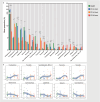The Subgingival Microbial Composition in Health and Periodontitis with Different Probing Depths
- PMID: 40284767
- PMCID: PMC12029188
- DOI: 10.3390/microorganisms13040930
The Subgingival Microbial Composition in Health and Periodontitis with Different Probing Depths
Abstract
The differences in microbiota between periodontitis and health have been extensively studied; however, knowledge about how the microbiota shifts from shallow to deep periodontal pockets remains limited despite its clinical importance in disease progres-sion and management. Patients diagnosed with stage III periodontitis commonly pre-sent varied probing depths (PD) within the same oral cavity, reflecting localized disease severity. This study aims to analyze the microbiome of subgingival plaques at various PDs in periodontitis patients. Subgingival plaques were collected from sixteen healthy subjects (health group) and periodontal pockets of sixteen stage III periodontitis pa-tients (PD 0-3 mm, PD 4-5 mm and PD 6-9 mm groups). A total of 64 subgingival plaque samples underwent 16S rRNA gene sequencing. The PD 6-9 mm group exhib-ited significantly higher alpha diversity than the health group, and distinct subgingival microbial community structures were observed in periodontitis patients, regardless of probing depth. The relative abundance of specific genera differed notably between health and periodontitis states; Corynebacterium and Cardiobacterium decreased, whereas Schaalia increased in shallow pockets (PD 0-3 mm) of periodontitis relative to the health group. Co-occurrence network analysis on the species level revealed that the PD 4-5 mm group had the most complex interspecies interactions, followed by the PD 6-9 mm and PD 0-3 mm groups. These findings indicate significant variations in mi-crobial diversity, composition, and interspecies interactions associated with periodon-tal health and periodontitis severity, highlighting their potential relevance for clinical diagnosis and targeted therapeutic strategies.
Keywords: microbiome; periodontitis; probing depth (PD); subgingival dental plaque.
Conflict of interest statement
The authors declare no conflicts of interest.
Figures





Similar articles
-
The Subgingival Microbiome of Periodontal Pockets With Different Probing Depths in Chronic and Aggressive Periodontitis: A Pilot Study.Front Cell Infect Microbiol. 2018 May 1;8:124. doi: 10.3389/fcimb.2018.00124. eCollection 2018. Front Cell Infect Microbiol. 2018. PMID: 29765908 Free PMC article.
-
Insights into the variations in microbial community structure during the development of periodontitis and its pathogenesis.Clin Oral Investig. 2024 Dec 2;28(12):675. doi: 10.1007/s00784-024-06074-7. Clin Oral Investig. 2024. PMID: 39617812
-
[Comparison of subgingival microbial profile of aggressive periodontitis, chronic periodontitis and periodontally healthy individuals].Zhonghua Kou Qiang Yi Xue Za Zhi. 2020 Jul 9;55(7):466-474. doi: 10.3760/cma.j.cn112144-20200413-00207. Zhonghua Kou Qiang Yi Xue Za Zhi. 2020. PMID: 32634885 Chinese.
-
Microbial signatures of health, gingivitis, and periodontitis.Periodontol 2000. 2021 Jun;86(1):57-78. doi: 10.1111/prd.12362. Epub 2021 Mar 10. Periodontol 2000. 2021. PMID: 33690899 Review.
-
Influence of periodontal surgery on the subgingival microbiome-A systematic review and meta-analysis.J Periodontal Res. 2023 Apr;58(2):308-324. doi: 10.1111/jre.13092. Epub 2023 Jan 4. J Periodontal Res. 2023. PMID: 36597817
References
-
- Papapanou P.N., Sanz M., Buduneli N., Dietrich T., Feres M., Fine D.H., Flemmig T.F., Garcia R., Giannobile W.V., Graziani F., et al. Periodontitis: Consensus report of workgroup 2 of the 2017 World Workshop on the Classification of Periodontal and Peri-Implant Diseases and Conditions. J. Clin. Periodontol. 2018;89:S162–S170. - PubMed
Grants and funding
LinkOut - more resources
Full Text Sources
Miscellaneous

